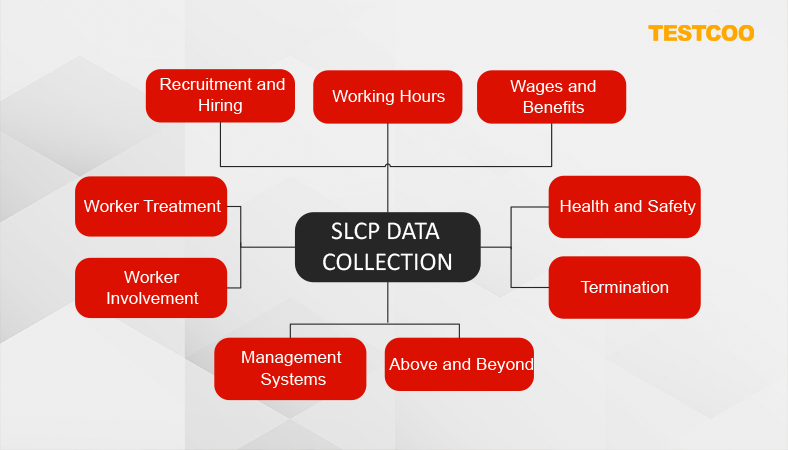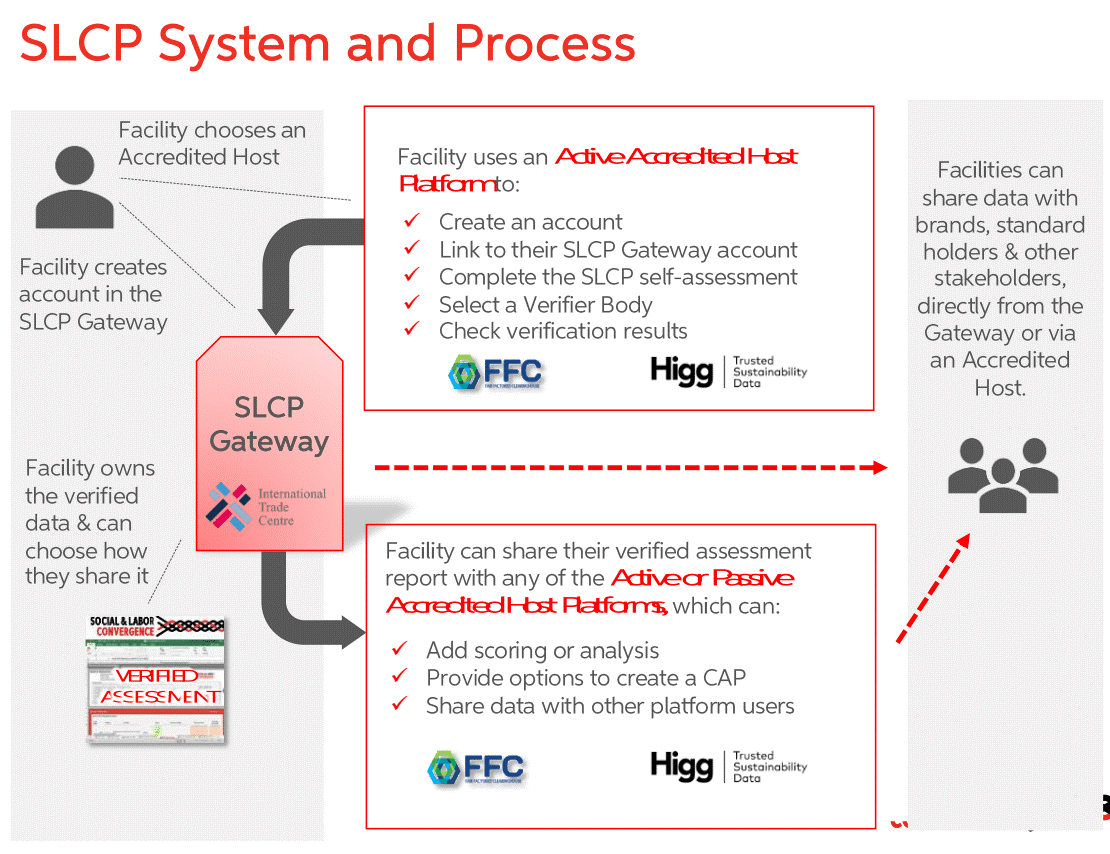SLCP- The Social and Labor Convergence Program

The apparel and footwear industry has traditionally been required to undergo costly, time-consuming and repetitive social audits to meet varying regulations and standards. SLCP allows responsible suppliers, manufacturers, brand representatives and other industry stakeholders to redirect time and resources spent on duplicative social assessment toward improving workplace conditions and ensuring fair, safe and gainful employment.?
The Social and Labor Convergence Program (SLCP) is a non-profit initiative established to reduce the number of social audits in facilities and provide credible social and labor data. SLCP eliminates audit fatigue, enables data comparison, and frees up resources for improvement programs. The ultimate goal is to improve social and labor conditions in global supply chains.
What does SLCP do?
SLCP has brought together diverse stakeholders to create and implement a common tool to reduce the time and money spent on social auditing. The aim of SLCP is to redirect savings from auditing to improving working conditions.
SLCP’s Converged Assessment Framework (CAF) will free up resources currently tied up in auditing and promote collaboration that will make tangible and lasting improvements to working conditions and workers’ lives.
Read?7 Difference between SLCP and Higg FSLM to learn the SLCP anf Higg FSLM comparision.
What are the benefits of SLCP?
The main benefit of an SLCP audit is that companies that have been verified are not required to be assessed multiple times by different bodies.
-A verified assessment can be shared with multiple apparel and footwear customers who use the SLCP framework. This aims to eliminate audit fatigue – eliminate duplication and reduce the number of social and labor audits, by replacing current proprietary assessment tools.
-The customer’s (buyer’s) aim for a verified assessment is to help educate suppliers to improve their site working conditions and take ownership of the results, to become a responsible business. It also promotes collaboration, helping to produce programs for lasting improvements.
The processes involved in SLCP Verification
In a nutshell, there are 3 stages, namely Data Collection, Verification and Data Sharing, and I'll be illustrating briefly them as below:
Stage 1 - Data Collection
Data collection is handled by the facility. In most cases, the facilities are factories. As its name suggests, during the Data Collection stage, the facility has to fill in data being requested in either Excel format or with the online tools. It is important to note that even with Excel completion, the file will still be uploaded to the platforms for processing.
Stage 2 – Data Verification
Verification happens when the facility selects a Verifier Body to verify the data when it is ready. A Verifier will then be sent by the selected Verifier Body to have an on-site verification of data. Once the site verification is done, verification report will be submitted to platforms and the facility will have 14 calendar days to accept or raise disputes to the verification report. It will naturally proceed to the next step if the report is accepted, but if disputed, it will be ruled by SLCP’s Verification Oversight Organization.
Stage 3 – Data Sharing
Data Sharing takes place once the verification report is finalized. Data is stored within the platforms but data ownership is with the facility. It’s entirely the facility’s decision to share the data with other parties, be they existing or new business partners.
Onsite Verification of SLCP
1. General Onsite Verification Requirements
Verifier must verify all questions that are applicable to the facility according to the Step chosen in the self/joint-assessment:

- – Recruitment and Hiring
- – Working Hours
- – Wages and Benefits
- – Worker Treatment
- – Worker Involvement
- – Health and Safety
- – Termination
- – Management Systems
- – Above and Beyond
? Even if the facility did not provide an answer to the applicable question, the Verifier has to verify what the correct answer is;
? Some Verifier selections in the Tool can open up questions that the facility did not see during the self/joint-assessment and therefore did not answer. The Verifier must provide the correct verification information to these unanswered questions.
2. Opening Meeting Onsite Verification Requirements
-The onsite verification must start with an opening meeting;
- ? To the extent possible, the opening meeting includes facility management, workers’ representatives and those individuals responsible for managing recruitment, contracts, wages, and health and safety to discuss verification objectives, scope, and methodology.
- ? Verifiers must encourage the facility to be open and transparent during the SLCP process.
- Authorization to take pictures must be requested;
- Verifier must inform management that the Verifier selects the workers to interview;
- If applicable, Verifiers must inform management that they wish to interview the head of the union(s) and worker representative(s).
3. Walkthrough Onsite Verification Requirements
- Verifier must take time to first look at the ‘big picture’ before focusing in on the detail’;
- Verifier must inform the facility about any inaccuracies during the verification;
-Verifier must follow any applicable facility H&S protocols.
4. Worker and Management Interview Onsite Verification Requirements
-Verifier must meet or exceed the minimum number of interviews;
-Verifier must interview a representative sample of workers;
-Verifier must interview the trade union and/or worker representative (if applicable to the facility);
-Worker interviews are strictly confidential and subsequent reports will not identify the names of interviewees nor their individual responses;
-Interviews must take place in a language understood by workers either with additional Verifiers or onsite interpreters;
-The verification team must be able to support at least the top two languages spoken by workers and the primary language spoken by management;
-Interpreters must be independent of the facility and trained to understand social compliance topics.
5. Document Review Onsite Verification Requirements
-Verifiers must review documents to understand the facility’s procedures and to verify specific claims about how the workforce is managed;
-When reviewing wages and hours, Verifiers must select three pay periods (recent, high, low production period) from the 12-month assessment period to verify the self/joint-assessment data. If closure of production happened, the pay period during/ after closure must also be included.
6. Document and Photo Attachment Onsite Verification Requirements
-Verifiers must include specific photographic evidence and/or documentation attached to questions of the Tool, selecting the question that best fits.
7. Pre-closing Meeting Onsite Verification Requirements
-Prior to the closing meeting, the Verifier must take the time to complete all “Inaccurate”, “Non-Compliance” (for Verification Summary) and “Updated during Verification” items to prepare for the closing meeting.
-The Verifier must have a final conversation with the union representative and/or worker representative interviewed at the beginning of the interview process, as applicable.
8. Closing Meeting Onsite Verification Requirements
-The onsite verification must end with a closing meeting.
TESTCOO SLCP verification
Our experts are on-site to review your corporate social responsibility and the effectiveness of its implementation and help you ensure reliable social compliance and impact assessments of both the social and labor aspects of your facility.
Our experts have fulfilled strict eligibility criteria and are qualified to:
- -Ensure the quality and integrity of their Verifier's SLCP verification
- -Review documentation and official records
- -Check that data gathered during assessment is complete and correct
- -Examine essential data on critical social and labor issues
- -Conduct an on-site assessment visit
- -Resolve facility’s concerns in post onsite verification
- -Prepare a verified assessment report
Assess responsible business practices in your global supply chain with Social & Labor Convergence Program (SLCP) verification from TESTCOO. Contact us now!
Free Sample Report Performance Quality Control
Download a sample report to keep control of your supply chain!
Featured Articles
 AQL Table | How to Read It
AQL Table | How to Read It TOP 10 Common Defects in Garments Quality Inspection
TOP 10 Common Defects in Garments Quality Inspection Product Packaging and Shipment Label requirements for Amazon FBA
Product Packaging and Shipment Label requirements for Amazon FBA What Is ASTM-F2413-18? Protective Footwear Standard
What Is ASTM-F2413-18? Protective Footwear Standard How to Conduct Third-Party Quality Control Inspections for Electric Scooters
How to Conduct Third-Party Quality Control Inspections for Electric Scooters SMETA Audit-What is SMETA Audit?
SMETA Audit-What is SMETA Audit? TESTCOO Supplier Verification/Certification Service SLCP, Higg FEM, GRS, GOTS
TESTCOO Supplier Verification/Certification Service SLCP, Higg FEM, GRS, GOTS Quality Control Inspection Company in China
Quality Control Inspection Company in China What is Quality Inspection? A Complete Guide
What is Quality Inspection? A Complete Guide Guidelines for Product Inspection in India
Guidelines for Product Inspection in India
Category
- Production Inspection Service
- Factory Audit
- Softline Inspection
- Hardline Inspection
- Electrics Inspection
- Certification
- Checklist
- Manufacturers
- Quality Assurance Basics
- Products Recall
- AQL
- Guidence and Standard
- News
- Supplier Management
- Amazon
- Protective Equipment
- e-commerce quality control
- Indian Manufacturing
- Soft Goods Quality Control
- Supply Chain Management
- Supply Chain Resilience
- E-Commerce Quality Control
- ISO 2859
- Supply Chain Optimization
- Garment Industry
- Higg Index




